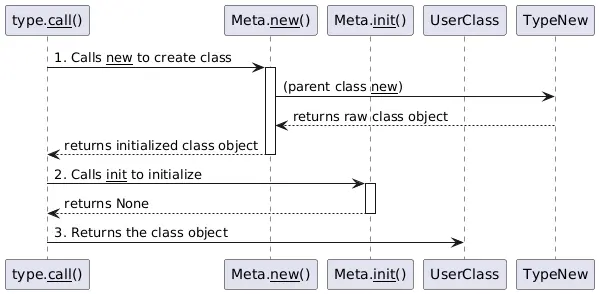
Python metaclasses are the ‘secret sauce’ behind how classes work. In this tutorial, you’ll learn what metaclasses are and how to use them with clear, step-by-step examples. By the end, you’ll be able to create custom metaclasses to empower your Python classes.
If you’re new to MetaClass, think of metaclasses as the “blueprints for blueprints.” Just as a class defines objects, a metaclass defines how classes behave. Ready to demystify this? Let’s dive in.
What are Python MetaClasses?
A metaclass in Python is a class that defines how other classes are created. In other words, classes are instances of metaclasses.
Still Confused? Imagine building a robot (your class) using a factory (your metaclass). The factory decides how the robot is assembled before it even exists.
In Python, the default metaclass is type. When you write class MyClass: pass, Python secretly uses type to create MyClass.
But what if you want to customize this process? But you can roll your own MetaClass to tweak how classes get made.
Built-in type Metaclass in Python
Python’s built-in type metaclass is the default metaclass that creates all classes in Python. It serves a dual purpose:
As a function: type(obj) returns the type of an object.
As a metaclass: type is responsible for constructing class objects themselves. When you define a class, Python uses type behind the scenes to create the class object.
You can explicitly use type as a constructor with three arguments:
MyClass = type('MyClass', (BaseClass,), {'attr': value, 'method': function})Code language: JavaScript (javascript)This creates a class equivalent to:
class MyClass(BaseClass):
attr = value
def method(self): ...The type metaclass defines how classes are instantiated, what attributes they have, and how they behave. When you create a custom metaclass, you’re typically inheriting from type and overriding methods like __new__ or __init__ to customize class creation. (We will explain the execution flow couple of sections later in the tutorial)
Since classes are objects in Python, and type creates classes, type is essentially the “class of classes” – which is why it’s called a metaclass.
How Are Python MetaClasses Useful?
MetaClasses unlock metaprogramming, the art of writing code that interacts with other code. It’s like giving your Python superpowers! They let you craft dynamic, flexible code perfect for frameworks or libraries.
Some of the benefits that MetaClasses bring to the table:
- Code reusability: Define behavior once, and all your classes get it—bam!
- Enforce constraints or design patterns (e.g., “Every database model must have a
created_atfield”). - Centralized Class Configuration: When you have lots of classes, changing them one by one is tedious. A MetaClass can apply changes to all of them systematically. No copy-paste nonsense!
- Hook into class creation to modify behaviour dynamically.
Think of them as a superpower. But with great power comes great responsibility—use them sparingly.
How To Create A MetaClass?
Let’s create a simple metaclass that automatically adds an created_by attribute.
class AutoCreatedByMeta(type):
def __new__(cls, name, bases, attrs):
# Add 'created_by' to the class
attrs['created_by'] = "Jane's Metaclass Factory"
return super().__new__(cls, name, bases, attrs)
class MyClass(metaclass=AutoCreatedByMeta):
pass
print(MyClass().created_by) # Output: Jane's Metaclass FactoryHow Python Metaclasses execution flow works?
What’s happening in the example above?
__new__Intercepts class creation.- We inject
created_bybefore the class is finalized
To ellaborate further, here’s roughly how under the hood program execution flow works:

Advanced MetaClass Examples
Enforcing Mandatory Methods
Imagine building an API client where every subclass must implement connect().
class APIClientMeta(type):
required_methods = ['connect']
def __new__(cls, name, bases, attrs):
for method in cls.required_methods:
if method not in attrs:
raise TypeError(f"{name} must define {method}")
return super().__new__(cls, name, bases, attrs)
class DatabaseClient(metaclass=APIClientMeta):
def connect(self):
return "Connected!"
# The following will raise a TypeError exception:
# class BrokenClient(metaclass=APIClientMeta): pass Boom! Now you’ve got compile-time safety.
Singleton with a Metaclass
Another example of an meraclass that defines singleton design pattern behaviour for any class that defines it:
class SingletonMeta(type):
"""
A metaclass that creates singleton instances.
Only one instance of any class using this metaclass can exist.
"""
_instances = {}
def __call__(cls, *args, **kwargs):
"""
Override __call__ to control instance creation.
This method is called when someone tries to create an instance of the class.
"""
if cls not in cls._instances:
# Create the instance only if it doesn't exist
instance = super().__call__(*args, **kwargs)
cls._instances[cls] = instance
return cls._instances[cls]Exmple of singleton Logger class utilzing this metaclass:
# Example usage: Logger class
class Logger(metaclass=SingletonMeta):
def __init__(self, log_level="INFO"):
self.log_level = log_level
self.logs = []
print(f"Creating logger with level: {log_level}")
def log(self, message):
self.logs.append(f"[{self.log_level}] {message}")
print(f"[{self.log_level}] {message}")Troubleshooting Tips
Here are a few things to be aware of :
- Order matters: __new__ runs when the class is defined, not when you make objects. Mix that up, and you’re toast.
- Inheritance chaos: Mixing MetaClasses with multiple inheritance is a beast. The derived MetaClass must jive with the base ones.
- Overengineering: You’re probably doing it wrong if your metaclass spans 100 lines.
A couple of common errors:
- “TypeError: metaclass conflict”: Ensure all base classes use the same metaclass.
- “AttributeError: ‘dict’ object has no attribute”: Check if you’re modifying
attrscorrectly in__new__.
Limitations & Gotchas
- Complexity: Python Metaclasses can make code harder to debug.
- Inheritance Issues: Mixing metaclasses with multiple inheritance? Good luck.
- Performance: Overusing them slows down class creation.
Watch out if you’re building a library—MetaClasses might clash with other tools your users love. For small jobs, class decorators might be your best buddy instead. I’ve learned to save MetaClasses for the big, hairy problems.
When to Use MetaClasses (And When Not To)
Use them for :
- Frameworks/ORMs (like Django models).
- Singleton patterns or logging decorators at the class level.
- Validating class attributes before runtime.
Avoid them for :
- Simple tasks (decorators or inheritance might suffice).
- “Just because.” They add complexity. There is a high chance you will regret it later.
Next Steps
Now that you know how to use MetaClasses, your journey doesn’t have to stop here. Here are some suggestions about the next steps:
- Descriptor Protocol: Combine MetaClasses and descriptors to create powerful property management systems.
- Abstract Base Classes (ABC): Python’s
abcmodule uses MetaClass to enforce abstract methods. Learning ABC and MetaClasses together unleashes unstoppable combos. - Code Generation: Use MetaClasses to build entire families of classes for specialized frameworks or domain-specific languages.
Also, read the official docs (but brace yourself).
Conclusion
And there you have it—Python MetaClasses demystified in this tutorial! They’re your ticket to metaprogramming glory, letting you bend classes to your will. Sure, they’re a bit intimidating at first, but you’ll master them with a little practice. Go wild with my examples, and let me know how it goes—happy 🐍 coding!
Discover more from CodeSamplez.com
Subscribe to get the latest posts sent to your email.

Leave a Reply